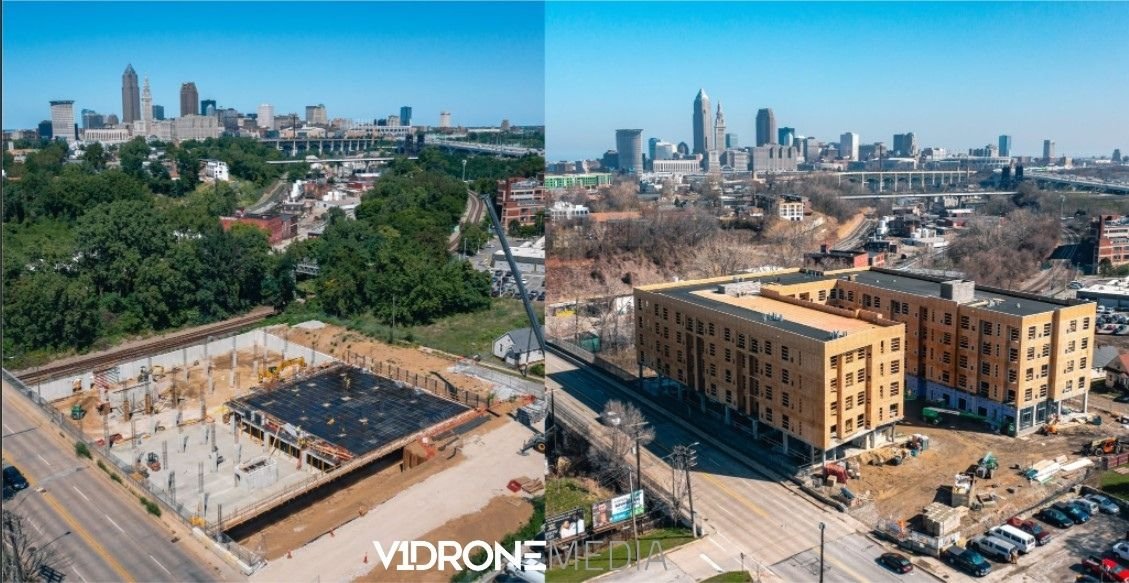The use of drones in construction is growing rapidly, with companies in this industry using drones for various tasks throughout the construction process. We count several construction companies as our clients, and here we are breaking down the uses of drones and other tools for construction services marketing.
The most common use of drones in construction is for marketing, because aerial photography and video showcase project site progress, action on the site, and the finished project better from the bird's eye view than from the ground. You can see more from the aerial view and show off the scale of the project, and the best way to get this type of content is to have ongoing construction progress documentation using drones.
How do construction companies use drone photography and video for construction marketing?
Social Media Content
Construction aerial photography and video generate great content to showcase the progress on the construction site to stakeholders and the public. They can also be used as early-stage marketing for the brokers if the building needs to be leased by tenants. Below are some examples: before/during photo and video clip that was posted on social media by our clients.
Before/During drone photo of a construction site on West 25th Street in Cleveland
2. Project Portfolio Showcase on Construction Company Website or YouTube Channel
Every construction company should have a section on their website to showcase the projects that they have been involved in. What better way to showcase them than with photos or videos of finished projects, maybe even an impressive hyper-lapse or timelapse video of the building going up during the construction?
3. Customer Proposals, Presentations, Business Development
While not all scopes of work require to have visual updates of the construction site, having this type of deliverable throughout the construction process may enhance your proposal, and even take it over the top all things being equal among the other bidders. Especially if the construction client is not local, which is often the case.
We have a construction client whose building owner is overseas, and having consistent visual updates is very valuable to them. It gives transparency and increases their confidence and trust in the builder.
4. Video Web Banners on Construction Company's Homepage
Have you heard that the website homepage, which is most often the landing page, is the most important page to optimize the content on because it gets the most traffic, and that's where the visitors decide if they want to browse further? A video banner of prominent projects that the construction company has built will impress many viewers and increase their confidence and motivation to take the next step: browse more or contact the builder. Here is an example.
Video is becoming a very important part of marketing strategy for many industries, including construction marketing strategy. If you'd like to know more about the reasons why read our blog post Why Is Video Important For Your Marketing?
What is the Return on Investment (ROI) of construction site progress monitoring and documentation?
Many construction companies leverage drones and other visual technology tools for more than just marketing, such as for enhancing customer communications, internal project updates, construction site security, and re-creating the built environments in BIM (Building Information Modeling) and creating digital twins.
In addition to drones, these tools are time-lapse cameras and 360 virtual tours. The visual output of these tools over the lifecycle of the project can be used and reused for various purposes, which can make the acquisition cost of construction site imagery very efficient, and its Return on Investment (ROI) increases with every use.
These tools are within the digitization trend in construction, facilities management, and other industries. This imagery can be used to re-create the built environment in 3D in BIM (used for construction and design) or as digital twins (usually used for facility maintenance and operations) to give companies a complete 3D visual model of the build. It is a digital documentation record that can be accessed at any time to send information about the building, reflect changes with its physical counterpart, and allow for materials ordering and scheduling (in the design/construction stage or for maintenance and expansions if the building is operational). These types of digital models can replace final building drawings and operations manuals.
We outline more drone uses on construction site on our blog post Top 4 Drone Uses in Construction Site Management.
If you'd like a quote for construction progress monitoring job or consultation on what equipment is best to use on your construction site for a specific purpose or a variety of uses, contact us!

